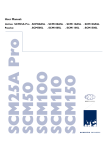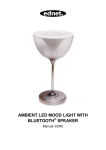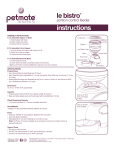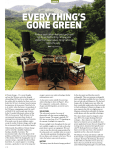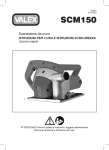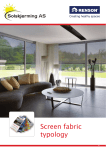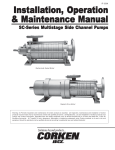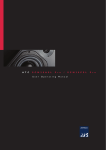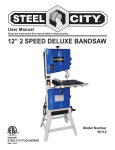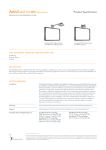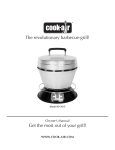Download User Manual:
Transcript
User Manual: Active: SCM25A Pro . SCM45APro . SCM50ASL . SCM100ASL . SCM110ASL . SCM150ASL . SCM50SL . SCM100SL SCM25A Pro SCM45A Pro SCM50 SCM100 SCM110 SCM150 Passive: . SCM150SL M U LT I C H A N N E L ® Safety Warnings SCM25/45/50/100/110/150 1. Read instructions – all the safety and operating instructions should be read before the appliance is operated. 2. Retain these instructions – the safety and operating instructions should be retained for future reference. 3. Heed warnings – all warnings on the appliance and in the operating instructions should be adhered to. 4. Follow instructions – all operating and other instructions should be followed. 5. Water and moisture - the appliance should not be exposed to dripping or splashing and no objects such as vases, should be placed on the appliance. 6. Ventilation - a minimum 0f 80mm is required at the rear of the appliance to ensure sufficient ventilation.The ventilation should not be impeded by covering the appliance with items such as table-cloths, curtains etc. Further, the appliance should not be built into an installation, such as a bookcase or cabinet, that may impede the flow or air around the appliance. 7. Heat – the appliance should be situated away from heat sources such as radiators, stoves or other appliances that produce heat. 8. Power sources - The appliance is of Class1 construction and shall be connected to a MAINS socket outlet with a protective earthing connection 9. Power cord protection – power supply cords should be routed so that they are not likely to be walked on or pinched by items placed upon or against them, paying particular attention to cords at plugs, convenience receptacles and the point where they exit the appliance. 10. Cleaning – the appliance should be cleaned only as recommended by the manufacturer. 11. Unattended periods – the power cord of the appliance should be unplugged from the outlet when left unused for a long period of time. 12. Object entry – care should be taken so that objects do not fall into the appliance. 13. Damage requiring service – the appliance should be serviced by qualified service personnel when: i. the power supply cord or the plug has been damaged ii. objects have fallen or liquid has been spilled into the appliance iii. the appliance has been exposed to rain or other serious liquid exposure iv. the appliance does not appear to operate normally or exhibits a marked change in performance v. the appliance has been dropped or the cabinet damaged 14. Servicing – the user should not attempt to service the appliance beyond those measures described in the operating instructions.All other servicing should be referred to qualified service personnel. 15. Grounding or polarisation – precautions should be taken so that grounding or polarisation means for the appliance are not defeated. 16. The Mains disconnection switch is located on the rear panel. Pressing the switch downwards will turn the unit on.The unit can be turned off by upward pressure on the switch. Please allow enough room around the unit to ensure the switch is readily operable when the unit is in use. 1 SCM25/ 25/50/100/ 50/100/ 110/ 150 SCM 110/ 150 SCM 25/45/ 50/100/ 110/ 150 Introduction Welcome. In selecting ATC you have chosen an example of the finest audio engineering available. ATC was founded on a principle of engineering excellence, and that principle still defines our products today. Given the right opportunities, ATC products will deliver exceptional audio performance, but the opportunities will only arise from careful and thoughtful installation and use. Please read the ATC was founded in London in 1974 by Australian emigre Bill Woodman, who still following manual fully. It will help you heads the company today. An enthusiastic pianist and engineer he was naturally understand the product and to realise its full drawn to loudspeaker design and after a period working at Goodmans, where many potential. We are happy to answer questions of the names that went on to found British loudspeaker companies began their and offer advice on any issues that arise careers, he struck out on his own.The premise on which ATC began is a simple one, through installation or use of ATC products. and one that in many respects is still true today: hi-fi loudspeakers tend to be Contact details can be found at the back of this detailed and accurate but of limited dynamic range, while professional monitor manual. speakers tend to express the opposite character. ATC products were designed from the outset to offer the best of both. It’s an easy concept to describe, but surprisingly difficult to engineer. The difficulty inherent in designing such loudspeakers is one of scale. Hi-fi levels of accuracy and detail call for lightweight moving parts and delicate engineering. Professional monitor levels of performance however demand far more robust components engineered to survive the rigours of high level use for extended periods.The only way to combine the two is through precision engineering of a class and scale more often associated with aerospace or motorsport. But the results are worth the effort and the cost. ATC loudspeakers, with their unique in-house designed drivers, combine the best of hi-fi and professional to devastating effect. ATC has become synonymous with active systems. Choosing to offer active loudspeakers (where the passive crossover network is replaced by active filters and Contents Page 3 Page 4 Page 5 Page 6 multiple power amplifiers) is simply a result of the uncompromising attitude to Introduction Page 2 Section 1 Section 2 Section 3 Section 4 Description Unpacking and Handling Monitor Placement Listening Active Monitors Section 5 Signal Cable Options Section 6 Operation Section 7 Connection Passive Monitors Section 8 Connection Section 9 Amplification Connections and controls Page 7 Active Monitors Specifications Page 8 Passive Monitors Specifications Care and Maintenance Section 10 Section 11 Warranty and Contact loudspeaker design.While passive systems still have their place, and ATC engineering skills can still bring remarkable results from them,“active” is a fundamentally better solution to the problems posed by accurate, high level music reproduction.The ATC instinct is always for the better solution. Not cheaper, not quicker, but better. It was the development of active loudspeakers that first brought ATC into electronics design and engineering. Active speakers demand multiple power amplifiers so ATC from the mid 1980s became not just a loudspeaker manufacturing company but an electronics manufacturer too.The further step from electronics for active speakers to a range of stand-alone amplifier products was natural and now means that ATC engineering is available from the recording desk or CD player output to the ears. From modest beginnings ATC has grown to become one of the very few manufacturers successful across both domestic and professional audio. By selecting ATC you join a group of music lovers, professional audio engineers, studios and musicians across the World that understand and value the engineering that goes into an ATC product - and the sound that comes out. 2 SCM25/45/50/100/110/150 Installation 1. Description 3. Monitor Placement The SCM25/45/50/100/110 and 150 are a range of three way loudspeakers. All of the range, excluding the SCM25 The subjective performance of any monitor loudspeaker will be influenced by the and SCM45 are available as passive or active units. acoustic character of the room in which it is used, and its position within the room. The SCM25 and SCM45 are only available as active Most often monitors are installed in rooms which are comfortable to sit and talk in. units. The product name suffix denotes the technology A mixture of carpets, curtains and soft furnishings will help ensure that middle and high featured in the product. frequencies are reasonably well controlled. There may however be low frequency “SL” denotes Super Linear Magnet technology and “A” problems; either too much or too little bass. To minimise low frequency problems denotes that the Loudspeaker includes active amplification. the monitors should be kept away from corners or walls. Start with them positioned Passive monitors are equipped with a “tri-wire” connection on appropriate stands 1 metre from the side walls and 2 metres from the back wall panel to enable separate amplification of the bass, mid In professional installations, try to avoid placing speakers on the console/desk meter and high frequency drivers. Active units have a built in bridge. Typically, this compromises the balance of the loudspeaker especially in the three way Amplifier with frequency, gain and phase lower mid range. If the balance is bass light, the monitors can be moved towards the correction which has been individually optimised at the back walls. Use the Bass Boost control for fine tuning rather than to compensate for ATC manufacturing facility. Adjustment of input sensitivity innapropriate positioning. For stereo listening, loudspeakers should be positioned and bass boost are available to the user via controls so they form an equilateral triangle with the listening position (See Fig.1). on the rear panel of the unit. Loudspeaker stand height should be chosen to position the loudspeaker acoustic axis at, or close to ear level (See Fig.2). All rooms vary and it is a good idea 2. Unpacking and Handling to experiment with both the listening and speaker position until a good compromise is reached. For professional installations the requirements are often very specific. The SCM25, 45, 50, 100, 110 and 150 are large heavy items Please consult with an experienced professional acoustician if necessary. Monitors and should be handled with care. Always employ a Monitors with an asymmetric (offset) driver array should be positioned such that the second person to assist in moving them. Unpacking is best midrange driver and tweeter are inboard. If the monitors are to be placed in any form carried out on the floor, with adequate open space of cabinet, adequate side and top clearance for cooling airflow must be provided. around the carton, preferably close to their final position. Alternatively, the Amplifiers should be removed and installed remotely. All ATC 3-way • Open the carton and remove all loose items. loudspeakers are designed with the mid-range dome as the reference acoustic axis. • Remove the upper Sratocell foam cap. With this in mind, the loudspeakers should be positioned with the mid-range dome • Remove the polythene or cloth bag, leaving at, or slightly below ear level (See Fig.3). the baffle protector in place. • Carefully lift the loudspeaker out from the lower Sratocell foam cap using the handles Fig.2 and the port opening as lifting points. • The speaker can now be positioned in the listening/control room Reference acoustic axis Position at ear level or up to 5 degrees above ear level • Remove the baffle protector. Loudspeaker Positioning - Stereo 4.Listening distance z The ear and brain tend to interpret distorted sound as loudness and thus 30° 30° underestimate the actual level of undistorted sound. The SCM25, 45, 50, 100, 110 x tan than conventional systems of a similar size and it is therefore advisable to begin listening dis ce tan ce y dis and 150, like all ATC monitors, demonstrate very much lower levels of distortion at an artificially low level and carefully increase the volume. It is also possible for the Fig. 1 SCM25, 45, 50, 100, 110 and 150 to produce sufficient sound pressure levels for your ears themselves to become a source of distortion and make the sound appear harsh, Any audible distortion indicates that either the system or your ears are being distance x = distance y = distance z overloaded and that the volume level should be reduced. 3 SCM25/45/50/100/110/150 Installation Active monitors 5. Signal Cable Options 6.Operation Balanced cable configuration is the preferred option, Diagram 4 and 5 illustrate the connection and control panels for the Amplifiers however unbalanced connection is possible. Diagrams 2 and 3 illustrate the signal cable connections required for used in the active monitors. Each feature is described below. each option. Balanced (XLR to XLR) connection offers 5.1 Mains Inlet: The supplied mains power lead (appropriate to the local lower noise and better immunity to “hum” pick-up. territory) should be connected here. Ensure that the mains voltage specified on Unbalanced (XLR to Phono or Two pole Jack) the panel corresponds with the local supply voltage. connection carries risk of hum caused by multiple signal earths. Hum problems resulting from unbalanced 5.2 Power Switch: Switches on the monitor. When switched on the indicator connection may be reduced by making ONE of the on the switch will illuminate. following modifications to the signal cable connections: If the driving preamplifier (or desk) is 5.3 Fuseholder: Should a monitor fail to switch on when the power switch is “double insulated” (i.e. has no mains earth), operated the fuse should be inspected. Lift out the fuseholder cover using a disconnect the signal cable screen at the RCA Phono small flat-blade screwdriver remove th efuse and inspect it for damage. If plug end. Alternatively, disconnect the signal cable required , a replacement fuse should be fitted. It should be stressed however that screen at the XLR end.This second option will make fuses most most often fail only because of a serious electrical fault. If this is the case then simply replacing the fuse will only result in another fuse failure. The the source the reference signal earth. monitor should be returned to ATC if a second fuse fails. Diagram 1 - input connection pins 5.4 Input Socket:The audio signal cable should be connected here. Balanced or or unbalanced cables may be used (See Section 3). PUSH 5.5 Bass Boost: 2 Pin 2, Signal (hot) 1 3 Pin 1, Screen Pin 3, Signal (return) Provides up to 6dB of gain (3dB for the SCM25 and SCM45) in the region of 40Hz. Use a small flat blade screwdriver to access the control. Adds more warmth and energy to the lower frequencies in music, at the expense of accurate transient reproduction. Note: Adjusting the bass boost without the ability to recalibrate may leave a pair of monitors unmatched. Diagram 2 - balanced cable 5.6 Level Trim : Provides access to an internal control that enables adjustment of input sensitivity. Use a small flat blade screwdriver to access the 3 Pin Male XLR Connector Two Core Screened Cable 3 Pin Female XLR Connector 2 Hot Return 2 1 Screen 1 3 To Monitor Input control. As supplied, monitors are calibrated to an input sensitivity of 1V. Note: Adjusting the sensitivity without the ability to recalibrate will leave a pair of monitors unmatched. 3 To Source Output Due to the nature of the electronics in ATC active loudspeakers it is quite normal for a sound to be heard from the speaker when the power is applied or disconnected. The noise heard will not damage the speaker and is quite normal. Although ATC uses the highest-grade components, a different noise may be heard from each speaker due to slight tolarance variations in the amplifier components. Diagram 3 - unbalanced cable 3 Pin Male XLR Connector 2 3 1 To Monitor Input Phono (RCA) Connector Two Core Screened Cable 7.Connection Hot Return for the audio signal. The mains cable is specifically supplied to comply with local Screen statutory safety approvals and alternatives should not be substituted. If you intend to To Source Output Two cable connections are required for each monitor: one for mains power and one use your monitors in an alternative territory please contact ATC for advice.The mains connection must always be earthed. The signal cable and plug (not necessarily supplied) should be of a good quality and XLR terminated. Poor cable and plug quality will compromise the performance of your monitors.The signal input pin configuration is illustrated in Diagram 1. 4 SCM25/45/50/100/110/150 Installation Passive Monitors Loudspeaker Positioning - 5.1 & 7.1 Surround 8.Connection The monitors are equipped with a “tri-wire” connection centre panel to enable separate amplification of the bass driver mid driver and tweeter. Remove the linking bars between rig h left t sub 0° 11 30° R 30° 0° 150° 150° (79 strand). Cable of smaller cross sectional area or fewer strands is unsuitable. For cable runs longer than 10m use 11 a 2.5mm minimum cross sectional area per conductor ce tan dis L distance C The terminals can accomadate either stripped cable ends or 4mm plugs: Always use good quality speaker cable with dis tan ce the three pairs of terminals if you wish to take advantage of the tri-wire facility. a significantly heavier gauge cable. Consult your dealer or consultant for specific cable recommendations. e RS ce tan dis 9 .A m p l i f i c a t i o n RR dis tan ce left side LR connection panel are connected back to the corresponding positive and negative terminals on the amplifier dista nc S L nce dista righ t side Ensure that the positive and negative terminals on each The choice of partnering amplifier for the monitors will have significant influence on the performance of the system. lef rea t r Consider the following when selecting the amplifier: ht rig r rea • With any passive loudspeaker there is a trade-off between low frequency extension and sensitivity. The monitors extended low frequency response means that its sensitivity • All loudspeakers should be equi-distant from the listening position: is relatively low. It is advisable therefore to select an distance L = distance C = distance R = distance LS = distance LR = distance RR amplifier of relatively high power capabilities. Use of an • For 5.1 systems, position the ‘surround’ speakers between 110 and 150 degrees under specified amplifier will result in the system sounding • If ideal positioning is not possible, position loudspeakers as close as possible distorted at high levels and may risk damage. Valve or solid to ideal state amplifiers with high output impedance should be • Try to avoid placing the subwoofer on the mid-point between two walls auditioned carefully to establish that their characteristic • For more details on setting up surround playback or monitoring systems reduced damping at low frequencies is acceptable. please contact you dealer or ATC direct. • Thanks in part to Super Linear technology and underhung voice coil construction, the monitors not only demonstrate 3-way systems extremely low distortion at all levels but also a greatly enhanced effective dynamic range. This exceptional distortion performance, also combined with very wide dispersion, will ruthlessly reveal deficiencies in ancillary acoustic axis: 5º below mid-range driver equipment. It is advisable therefore to audition the monitors with your proposed amplifier and ancillary system. 2-way systems acoustic axis: mid point between bass/mid and tweeter 5 SCM25/45/50/100/110/150 Installation Diagram 4 - SCM25A and SCM45A Pro connection and control panel Input sensitivity (full output) bass boost Designed and manufactured by Acoustic Transducer Company Gloucestershire GL6 8HR England 1v/2.2dBu (ref.) 2v/8.2dBu +3dB 0dB (ref.) Tri - AmpPack High Performance Active Loudspeaker Laite on liitettävä suojakoskettimilla varustettuun pistorasiaan Apparatet må tilkoples jordet stikkontakt Apparaten skall anslutas till jordat uttag 115/220 - 230 V fuse: 115V :T6.3A H/250V 220 - 230V :T3.15A H/250V 1: 2: 3: WARNING MAINS INPUT 50/60 Hz THIS EQUIPMENT MUST BE EARTHED CAUTION RISK OF ELECTRIC SHOCK DO NOT OPEN serial no. model 2000m CHECK VOLTAGE BEFORE USE voltage can only be safely used lower than 2,000 metres altitude can only be safely used in non-tropical weather RETURN TO MANUFACTURER FOR DISPOSAL Acoustic Transducer Co. Is a trading name and NO USER SERVICEABLE PARTS INSIDE Is the registered Trade Mark of Loudspeaker Technology Ltd. Diagram 5 - SCM50/100/110/150 connection and control panel Tri - AmpPack High Performance Active Loudspeaker bass boost Input sensitivity (full output) 1v/2.2dBu (ref.) 2v/8.2dBu +6dB 0dB (ref.) Designed and manufactured by Acoustic Transducer Company Gloucestershire GL6 8HR England balanced input fault WARNING ! THIS EQUIPMENT MUST BE EARTHED CAUTION RISK OF ELECTRIC SHOCK DO NOT OPEN PUSH Apparaten skall anslutas till jordat uttag Apparatet må tilkoples jordet stikkontakt 2 1 3 Laite on liitettävä suojakoskettimilla varustettuun pistorasiaan 2000m model 6 POWER CONSUMPTION 425 WATTS MAX. MAINS INPUT 50/60 Hz POWER CONSUMPTION 625 WATTS MAX. 100/115/220 - 230 V fuse: 100V :T6.3A H/250V 115V :T5A H/250V 220 - 230V :T3.15A H/250V can only be safely used lower than 2,000 metres altitude can only be safely used in non-tropical weather serial no. voltage NO USER SERVICEABLE PARTS INSIDE CHECK VOLTAGE BEFORE USE Acoustic Transducer Co. Is a trading name and RETURN TO MANUFACTURER FOR DISPOSAL Is the registered Trade Mark of Loudspeaker Technology Ltd. SCM25/45/50/100/110/150 Specifications Active Monitors Drivers: HF MF LF SCM25A Pro SCM45A Pro SCM50ASL SCM100ASL SCM110ASL SCM150ASL 25mm (1") 75mm (3") 164mm (6.5") 25mm (1") 75mm (3") 164mm (6.5") 25mm (1") 75mm (3") 234mm (9") 25mm (1") 75mm (3") 314mm (12") 25mm (1") 75mm (3") 234mm (9") 25mm (1") 75mm (3") 375mm (15") Amplitude Linearity ±2dB 74Hz – 17kHz 70Hz – 17kHz 70Hz – 17kHz 65Hz - 17kHz 65Hz - 17kHz 60Hz - 17kHz Cut-off Frequencies (-6dB free standing) 47Hz & 22kHz 42Hz & 25kHz 38Hz & 25kHz 32Hz & 25kHz 32Hz & 25kHz 25Hz & 25kHz Matched Response ±0.5dB ±0.5dB ±0.5dB ±0.5dB ±0.5dB ±0.5dB ±80° Coherent ±10° Coherent ±80° Coherent ±10° Coherent ±80° Coherent ±10° Coherent ±80° Coherent ±10° Coherent ±80° Coherent ±10° Coherent ±80° Coherent ±10° Coherent 112dB 112dB 115dB 115dB 117dB Dispersion: Horizontal Vertical 109dB Max Continuous SPL @ 1metre 380Hz and 3.5kHz, 4th order, critically damped with phase compensation Crossover Frequencies Input Connector Female XLR Input Sensitivity 1V rms (0dBV/1.1dBu) balanced (referenced to full output) Sensitivity Trim 0 to -6dB Input Impedance 10k Ohms per leg Amplifier Output: LF continous MF continous HF continous 150 Watts 60 Watts 25 Watts 150 Watts 60 Watts 25 Watts OverallWeight 0 to +3dB 200 Watts 100 Watts 50 Watts ) ( 0 to +6dB ) 716 x 351 x 480 28.2 x 13.8 x 18.9 832 x 398 x 581 32.8 x 15.7 x 22.9 Classic 716 x 304 x 480 28.2 x 12.0 x 18.9 832 x 398 x 581 32.8 x 15.7 x 22.9 884 x 498 x 647 34.8 x 19.6 x 25.5 Tower 1020 x 334 x 480 40.2 x 13.2 x 18.9 1167 x 428 x 581 45.9 x 16.9 x 22.9 1139 x 528 x 647 44.8 x 20.8 x 25.5 Pro Pro 264 x 430 x 414 10.4 x 16.9 x 16.3 30.0kg (66lbs) 353 x 600 x 414 13.9 x 23.6 x 16.3 36.0kg (79.2lbs) Classic Tower Power Requirements: Voltage Frequency 200 Watts 100 Watts 50 Watts Active peak momentary Gain Reduction on all channels, r.m.s. power limiter on h.f. channels. Overload Protection Bass Boost (40Hz continously variable) ( Loudspeaker Dimensions (HxWxD)mm (HxWxD)in. 200 Watts 100 Watts 50 Watts 200 Watts 100 Watts 50 Watts 716 x 626 x 501 28.2 x 24.6 x 19.7 73kg (160.6lb) 884 x 498 x 628 34.8 x 19.6 x 24.7 75kg (165.3lb) 49kg (107.8lb) 65kg (143lb) 49kg (107.8lb) 65kg (143lb) 75kg (165.3lb) 53kg (116.8lb) 68kg (149.9lb) 77kg (169.8lb) Internally set 115/220 - 230V 50/60Hz Internally set 100, 115, 220 - 230V 50/60Hz Stands/Brackets Floor stands included with Hi-Fi products only Cabinet Finishes All products: Standard real wood veneers are available in Black Ash, Mahogany, Cherry and Natural Oak. Other veneers and finishes can be supplied to special order. Specifications comply with the following standards: Australian Standard Specification No 1127 "Sound System Loudspeakers" Part 5, IEFE Specification Standard No 219-1975 E. & O.E. The policy of ATC is that of coninuous design and development. ATC reserves the right to alter products and specifications without prior notice. Acoustic Transducer Co. is a trading name and ATC is the registered trade mark of Loudspeaker Technology Ltd. 7 SCM25/50/100/110/150 Passive Monitors Drivers: SCM50SL SCM100SL SCM150SL 25mm (1") 75mm (3") 234mm (9") 25mm (1") 75mm (3") 314mm (12") 25mm (1") 75mm (3") 374mm (15") Amplitude Linearity ±2dB 70Hz – 17kHz 65Hz - 17kHz 60Hz - 17kHz Cut-off Frequencies (-6dB free standing) 38Hz & 25kHz 32Hz & 25kHz 25Hz & 25kHz ±0.5dB ±0.5dB ±0.5dB ±80° Coherent ±10° Coherent ±80° Coherent ±10° Coherent ±80° Coherent ±10° Coherent Max Continuous SPL @ 1 metre 112dB 115dB 117dB Crossover Frequencies 380Hz and 3.5kHz, 4th order, critically damped with phase compensation HF MF LF Matched Response Dispersion: Horizontal Vertical Binding Posts/4mm Sockets (Tri-Wire capable) Input Connector 91dB 88dB 85dB Sensitivity @ 1 Watt/metre 8 ohms Nominal Impedance 100 - 1500 Watts Recommended Power Amplifier: Loudspeaker Dimensions (HxWxD)mm (HxWxD)in. OverallWeight Classic 716 x 304 x 425 28.2 x 12.0 x 16.7 832 x 398 x 526 32.8 x 15.7 x 20.7 884 x 498 x 592 34.8 x 19.6 x 23.3 Tower 1020 x 334 x 425 40.2 x 13.2 x 16.7 1167 x 428 x 526 45.9 x 16.9 x 20.7 1139 x 528 x 592 44.8 x 20.8 x 23.3 Classic Tower 41kg (90.4lb) 45kg (99.2lb) 57.0kg (125.7lb) 61kg (134.5lb) 68kg (149.9lb) 70kg (154.3lb) Floor stands included with Hi-Fi products only Stands/Brackets Cabinet Finishes All products: Standard real wood veneers are available in Black Ash, Mahogany, Cherry and Natural Oak. Other veneers and finishes can be supplied to special order. Specifications comply with the following standards: Australian Standard Specification No 1127 "Sound System Loudspeakers" Part 5, IEFE Specification Standard No 219-1975 E. & O.E. The policy of ATC is that of coninuous design and development. ATC reserves the right to alter products and specifications without prior notice. Acoustic Transducer Co. is a trading name and ATC is the registered trade mark of Loudspeaker Technology Ltd. 10. Care and Maintenance High technology material finishes are used in this product.The surfaces are durable and with a little care can be kept as good as new even under conditions of heavy use. Normally a dry duster will be all that is required to keep the finishes clean. 1 1 . Wa r r a n t y a n d C o n t a c t All ATC products are guaranteed against any defect in materials or workmanship for a period of two years Heavy soiling can be cleaned using a cloth slightly moistened with a non-abrasive from the date of purchase. Within this period we will household cleaner. supply replacement parts free of charge provided that There are no components within the speaker that can be considered expendable, the failure was not caused by misuse, accident or negligence. or that would benefit from regular maintenance. There is no requirement for any kind of routine service work and there is no schedule for preventative maintenance. There are no user replaceable parts within the speaker and in the unfortunate event Purchasers who complete and return the Warranty Card will have their warranty period of any malfunction, repair should be referred to either the supplying dealer or extended up to a period of six years from the consultant, the relevant importer, or ATC. ATC has every confidence in the quality date of purchase.This guarantee does not limit of each product that it manufactures. statutory rights. ATC can be contacted at: Loudspeaker Technology Ltd, Gypsy Lane, Aston Down, Stroud, Gloucestershire GL6 8HR, UK. 8 Telephone: 01285 760561 Fax: 01285 760683 Email: [email protected] Website: www.atc.gb.net Loudspeaker Technology Ltd, Gypsy Lane, Aston Down, Stroud, Gloucestershire GL6 8HR United Kingdom Telephone 01285 760561 Fax 01285 760683 Email: [email protected] Website: www.atc.gb.net










